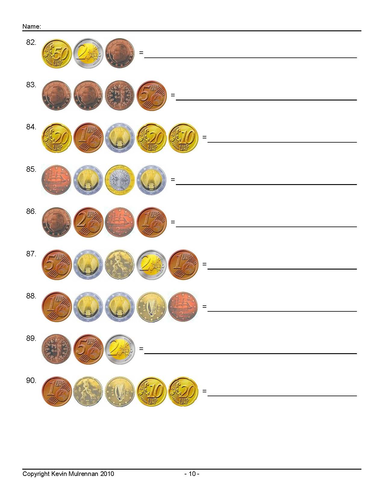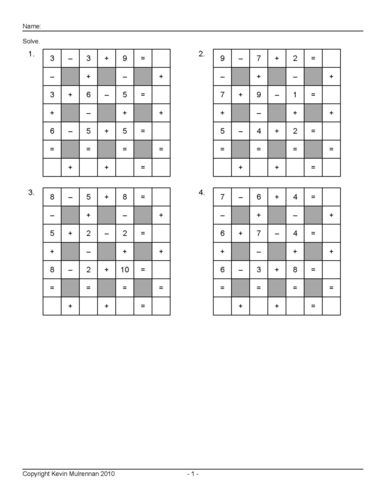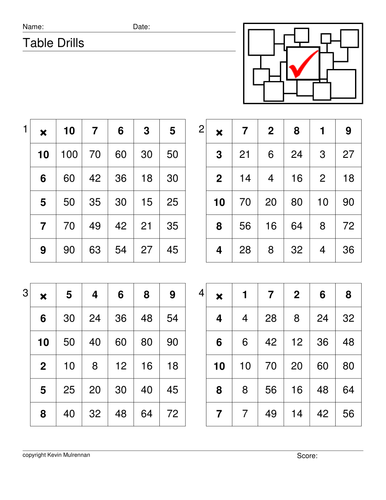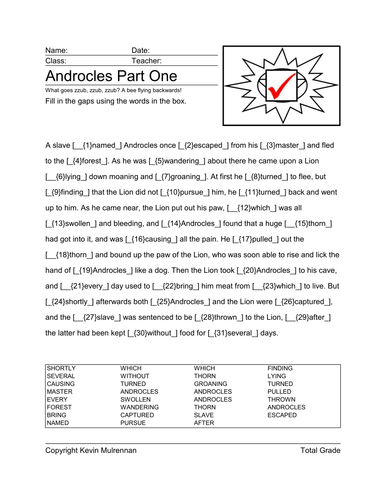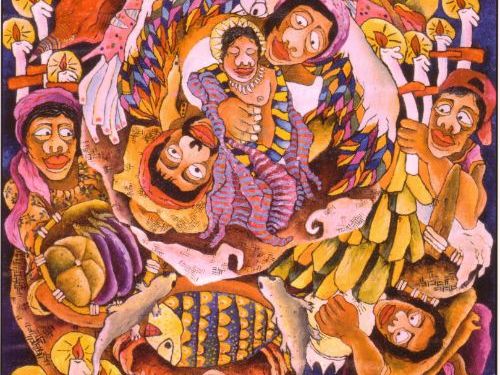404Uploads
119k+Views
40k+Downloads
All resources

Freebie Free 5 Worksheets Maths Shopping Arithmetic KS1 KS2 Money Counting
A freebie.
If you like these I have 100 for sale in my shop.
I have designed 5 worksheets on Money and Shopping for primary school children. I have used a variety of items, a variety of difficulty and a variety of numbers of questions per sheet. Pupils write on the sheets the total cost. e.g. a milkshake costs £2.90 a hot dog £1.65 How much would 2 milkshakes and 3 hotdogs cost? There is plenty there to reinforce the work done in the classroom. Good for extra homework or additional work for the bright ones. Answer sheets are provided for all worksheets.

Freebie Telling Time KS1 KS2 Mathematics Clocks Minutes Hours
A sheet where pupils have to put the correct times in.
If you like this, please visit my shop where you can buy a full set.

Freebie 2 French Wordsearches KS1 KS2 Perfect for Friday Afternoons With Answers
2 French wordseaches with answers.
Each one has 20 basic words to find.
Perfect for rainy Friday afternoons, homeworks etc.
If you like these, please visit my shop where you can purchase 500 of these at a very reasonable price.

Euro Coins Worksheets KS1 KS2 Mathematics Freebie
A worksheet that pupils have to fill in. They have to add up the coins.
If you like it, please visit my shop that has an enhanced similar product.

Freebie Fractions KS1 KS2 Mathematics Simplifying Mixed Fractions etc
An example freebie of my self-designed fractions sheets.
If you like this one, please take a look at my shop.
You could but half a million questions on fractions.
Or maybe ones on simplifying fractions, Mixed fractions etc.
Please look for the bundles if you are looking for great value.

Freebie Telling the Time KS1 KS2 Mathematics
A sheet with answers where pupils have to draw the hands to show the time on a small clock.
If you like this, please visit my shop where there is a more sophisticated product.

Maths Puzzle Across Down Addition and Subtraction Puzzle Plus Answers
Great for reinforcing maths.
Across-Downs is a fun activity that reinforces addition and subtraction skills.
The object of the exercise set is to find the answer for each row and column, then use those answers to calculate the final answer in the lower right-hand corner of the puzzle.
This tests addition and subtraction.
If you like this freebie, please visit my shop which has loads of puzzles for sale. Buy the bundles for best value.

Table Drills Mathematics Multiplication KS1 KS2 Maths Freebie Free
If you like this resource more available in my shop.
Fill in the gaps to get the correct multiplication answer.

Latin Word Search Freebie plus answers Cambridge Latin Course
A freebie.
A Latin word search.
If you like this one, I have 500 for sale in my shop.

Aesop Fable Cloze Test Androcles Classics Latin
A cloze test on an Aesop fable.
If you like this one I have a collection in my shop.
You get many, many more of them at a reasonable price.
Great timefiller for Froday afternoons or homework.
If you like the product, please leave a good review, especially as it’s FREE! Thank you!

Christmas Powerpoint Free Freebie Lesson Taster Advent Religious Studies
A freebie.
A nice powerpoint on the religious aspect of Christmas.
I’m hoping to interest you in buying my series of Christmas lesson on R.E.

Free Freebie Good Samaritan Lesson Simple and Effective for Year 4 R.E. Literacy
Got me a job so must be reasonable!
A simple lesson plan, worksheet, powerpoint.
Great for discusiing with pupils.
I have plenty of maths, literacy, languages and Literacy stuff so have a look after downloading this freebie.

Christmas Five Powerpoints Plus Planning Catholic Flavor
Five powerpoints plus planning.
I’ve converted the powerpoints to a pdf and you can download and have a good look.
sample planning:
Ask children to think about their literacy lessons – TTYP and name the important details that are needed in telling a story
(e.g. time, place, characters and events).
Ask children to the recall names of the four main Gospels.
Do they all tell the same story? (Essentially yes but lead children towards idea that they are different versions of the same story).
Use analogy of an incident occurring on the playground – would each child tell the same incident in the same way? No they would tell their version of the same event – some details and word choices would differ.
Talk about today’s WALT and explain that we are going to be looking at some different Gospel accounts of the birth of Jesus Christ. Explain to ch that, in order to achieve their WALT, they will need to be comparing and contrasting everything which they read.
Explain briefly that three out of the four Gospels deal with the birth or Christ; there are many similarities and many differences in the way in which the Gospels record and explain the event.
For today’s lesson we are going to focus on Matthew’s Gospel and Luke’s Gospel.
Children to have Bibles on carpet. Read the story of the birth of Jesus in the Gospel of Matthew Mt. 1: 18-2:23 and the Gospel of Luke Lk. 2: 1-14.
Using the PPT ask, show children the following table:
Details found only in Matthew’s Gospel.
Details found only in Luke’s Gospel.
Details found in both Gospel’
Discuss possible reasons for the differences in the two accounts. They are coming from two different people; points of view; written at different times but the basic story is the same.
Briefly recap last lesson. Which two Gospels did we look at? Which story were we reading? Did both Gospels tell the story in

Christmas Around The World Fun resources French German Spanish Italian
Loads of fun planning for Christmas around the World.
Most is French.
But a good chunk of German.
And a nice sprinkling of Italian and Spanish.
Highlights are short Christmas plays in French, German and Italian. And a lovely short Spanish powerpoint on the Nativity.
plus fun songs, quizzes, powerpoints, games etc
You get well over 100 files so great value.
sample French play
Petite pièce de théâtre pour Noël – Christmas play
Personnages
Trois bergers
Un ange
Les Trois Rois Mages
Marie
Joseph
L’aubergiste
Les animaux (enfants masqués)
Un choeur
Deux narrateurs
Narrateur 1: Il est tard. Trois bergers gardent leurs moutons sur une colline.
Berger 1: Brrr! Il fait froid! Passe-moi une couverture!
Berger 2: Voilà!
Berger 3: Regardez! Qu’est-ce que c’est?
Berger 2: C’est une étoile?
Berger 1: Ah non! Ce n’est pas une étoile!
Berger 3: Aïe! J’ai peur! Qu’est-ce que c’est?
Ange: N’ayez pas peur! Cette nuit, à Bethléhem, est né un enfant. Il s’appelle Jésus. Partez tout de suite et trouvez l’enfant!
Narrateur 1: Alors les trois bergers partent. Ils vont chercher l’enfant à Bethléhem.
Marie et Joseph arrivent à Bethléhem. Marie attend un enfant. Elle est très fatiguée.
Marie: Je suis fatiguée, Joseph.
Joseph: Trouvons une auberge.
Narrateur 1: Marie et Joseph cherchent une auberge mais il n’y a pas de place à Bethléhem.
Ils arrivent enfin à une petite auberge. Ils frappent à la porte.
Toc, toc, toc!
L’aubergiste: Oui? Je peux vous aider?

Gunpowder Plot Guy Fawkes Planning Year 6 Literacy
lessons for this interesting topic plus some maths.
sample:
In Jotters
As a class think about what a newspaper is and where we have seen them. Can anybody name any famous newspapers? When did we last read a newspaper? Who knows the sort of things we read in a newspaper? Create a list on flip chart paper. Give children 30 seconds in talk partners to discuss answers and share.
Show class an example of a newspaper front page. Can anybody name any of the different features? Call children out to front to highlight on IWB. Children are then sent off to have a go at annotating a real-life example on their own.
Children will then be stopped and asked where they are with the task.
As a class revisit work from the previous lesson (refer to working wall.) What can we remember from last lesson? Can you name any features of a newspaper?
Children to be given a worksheet with cut outs from a newspaper article. Can any of you recognise these different segments of a newspaper article? Where would this segment go in a newspaper?
Children will be asked to justify their choices as to why they have put a segment of the article where they have. Why would you put this here? Does this segment make sense here?
Children to use talk partners to discuss what an orientation paragraph is and what they think the purpose is. Create an expectations vs reality table on flipchart – to be put up on the learning wall. What is an orientation? Where do you think an orientation goes in a newspaper?
Children to be discuss the 5 W’s and what they are. Children to be given an example of a newspaper article and asked if they can see any of the W’s in there.
Children to be asked to begin using their understanding of an orientation paragraph to complete a number of different tasks.

Year 6 Maths Mean Median Mode Averages Range
A couple of nice lessons on these Maths topics.
Plus a little bit of spelling and formal and impersonal lessons.
sample:
LO: To state mathematical averages. (Hexagons and Pentagons)
For each of these questions, state the median, mode and mean average. Copy the data into your book. The layout is modelled in the first question.
MUST:
Maths Assessment Scores: 14 12 13 9 14 14
Mode:
Median:
Mean:
Football team Goals: 0 4 8 2 2 2 0 4 2 4
Visits to the seaside this year: 0 6 4 12 2 4 8 6 10 8
SHOULD:
4. Science Assessment Scores: 22 22 10 30 36
Hockey Team Goals: 3 6 12 0 0 0 9 12 10 6
Visits to Cinema in a year: 12 16 8 24 4 12 8 16 12 4
CHALLENGE
8. Spelling Scores: 6 7 9 2 4 5 0 4 1 2 6 5 5 5 8 9
Number in Family: 4 8 4 10 12 6 4 6 8 6 9 7
LO: To state mathematical averages. (Hexagons and Pentagons)
For each of these questions, state the median, mode and mean average. Copy the data into your book. The layout is modelled in the first question.
MUST:
. Maths Assessment Scores: 14 12 13 9 14 14
Mode:
Median:
Mean:

Private Peaceful Michael Morpurgo Lesson Year 6 plus some Maths
Great lesson on this interesting book.
Plus some nice Maths.
Great for year 6.
sample :
Display the image from the front of the book. What does the title of the book tell you? What could the book be about? Why do you think that? Introduce the title.
Children to identify what the book is about? What is the theme? Genre? What makes you think this?
Children to make predictions about the book in groups using the cover – share and discuss ideas.
Share extract from blurb ‘As young Thomas Peaceful looks back over his childhood from the battlefields of the First World War, his memories are full of family life in the countryside.’ 5ws and predictions modelled by CT.
What has changed? Why has your opinion changed? What questions and predictions can you make now?
Resources:
Book cover, sentence starters, 5Ws sheet (LA), blurb extract
Children to be reminded of the previous lesson. What did we learn? What do we think the text book is about? What happened in chapter one? Play BBC schools episode 1 -
Children are to be given the first paragraph of the book. What is the theme? What is the genre of the book?
Children to use talk partners and class discussion to list the characters involved in the first chapter and paragraph. Who are the characters we have met? What do we know about Tommo and his older brother Charlie? What is their relationship like? In this chapter, Tommo starts a new school – how would he be feeling about this? Look at the kindness of Molly – why does she act this way? Why doesn’t big Joe go to school? How would this be different today?

Year 5 Autumn 2 Literacy Inc Remembrance Sunday Morpurgo etc
Some planning and powerpoints.
Sample:
(BOOKS)
Go through the first few slides of the ppt. Discuss that we are going to be writing a letter pretending we are a soldier on the front line writing to their family or friend.
Have an A3 letter on the board. What do chn notice straight away?
Discuss the purpose. Why do we have the date? Why do we have the address?
Resources:
Checklist
Letter example – one per child and A3 for WW
(BOOKS)
Quickly recap the lesson from yesterday.
Quick fire feature checklist quiz
Read the passage. Discuss any words that are unfamiliar.
Chn are to work as a class to identify the main events. Can they now order the events? Remind chn that each event is a new paragraph
Can we write linking words for each of the paragraphs? All chn are to have a go and write linking sentences/words in between their events.
Resources:
Read passage from war horse of an event for the chn to write a letter from.

Literacy planning year 6 Tuesday by David Wiesner
couple of lesson plans and some worksheets.
Sample: Share L.O and STS with the children.
Introduce the cover for the new book – what do you predict will happen in the story? I predict that…….because
Why do you think the book is called Tuesday? Has the time got anything to do with it? I think that it is called Tuesday because….
Give children images taken from the book – what order should they go in? encourage groups to discuss the order as a group – explain that there is no right or wrong answer because they are predicting.
Invite children to share the order they chose and justify their choices.
CT model writing the story using the order they have chosen and time connectives. Model THINK, SAY, WRITE, CHECK method for writing. Remind children of noun phrases to add interesting detail. Encourage MA children to use complex sentences.
Resources:
Tuesday images
Sentence starter flash cards (differentiated)
Time flash cards
Images for books
Share LO and STS.
What do we know about the story so far? What are the main events? Children to share their work from previous lesson.
Watch:
How has the order changed from what you predicted? Arrange key images from the story in chronological order on the working wall.
Language starters to retell the story – ‘So far I have discovered that…’ ‘First, then, after that…’ Whilst x was… y was…’What is inference? Where have you seen it before? Why is it important with this text? Establish that it has no words so we must assume what is happening to tell the story.
Use the PowerPoint to tell the story as a class.
Share L.O. and vocabulary – where are we on the learning journey.
Ink Waster – Jotters – 2 minutes to write down everything you remember about the story.
Key Questions
When did it happen? Where did it happen? Did anyone see anything?
Display an image – Can you explain what is happening? Partner talk using language ladder openers to support – children to share with class.
Give groups of children images from the story and time connective sentence starters – children to sort the pictures into the correct sequence and use time connectives to retell.
Explain written task.
What is a noun phrase? What is an adverbial phrase? How would these be applied to this piece of writing?
CT model writing against STS

Catholic RE religious Studies Planning years 4 and 5 297 Page pdf Advent Lent
A 297 page pdf with Catholic RE planning. Suitable for years 4 and 5. Easily adaptable for personal use.
Lots of references to the bible.
Topics covered include Holy Week, Lent, Easter, Christmas, Advent, Creation, Baptism, Parables, Miracles etc
There’s an assessment sheet that pupils can write on and insert into their books.
sample: Explore with children words we might use to describe significant people in our lives and what they do for us (e.g. friend, parent, brother, etc.)
l What words and statements would the children use to describe God?
l Provide children with blank alphabetical word bank sheets to record words they would use for God. This activity could be done in small groups.
l Share findings with the rest of the class and reasons for choosing certain words.
l The Bible is a source of knowledge for Christians about what God is like. Explain to the children that in this unit of work we will be learning about some important images of God that we find in the Old Testament.
l Recall some of the images of God that the children have suggested. Explain that an important image of God for Christians and indeed for the Jewish people is that of the Creator.
l What does it mean to create something? What responsibility does this entail?
L2 That every human person is made in the image and likeness of God and is called to reflect God’s love.
l Know the story of the creation of human beings in the Book of Genesis.
l Understand what being created in the image and likeness of God means.
l Understand that human beings have similarities and differences that should be valued and respected by everyone.
l Explore ways in which Christians can work to value other people, especially those who are different from them.
l Research, discuss and write about the story of Creation of human beings and explore ways in which we can work to value other people especially those who are different from us.




